beijingwalker
ELITE MEMBER

- Joined
- Nov 4, 2011
- Messages
- 65,195
- Reaction score
- -55
- Country
- Location
RISE OF THE MACHINES
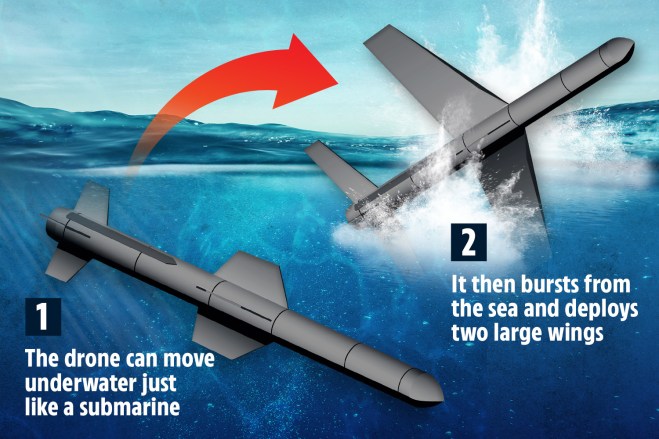
CHINESE scientists are developing flying submarines designed to burst from the water and take to the skies on fold-out wings.
The sinister stealth craft are meant to dodge both radar and sonar and could hunt in packs to ambush aircraft carriers, experts say.

A prototype Chinese drone can sail underwater and fly at 75mph on fold-out wingsCredit: Nanjing University of Aeronautics and Astronautics
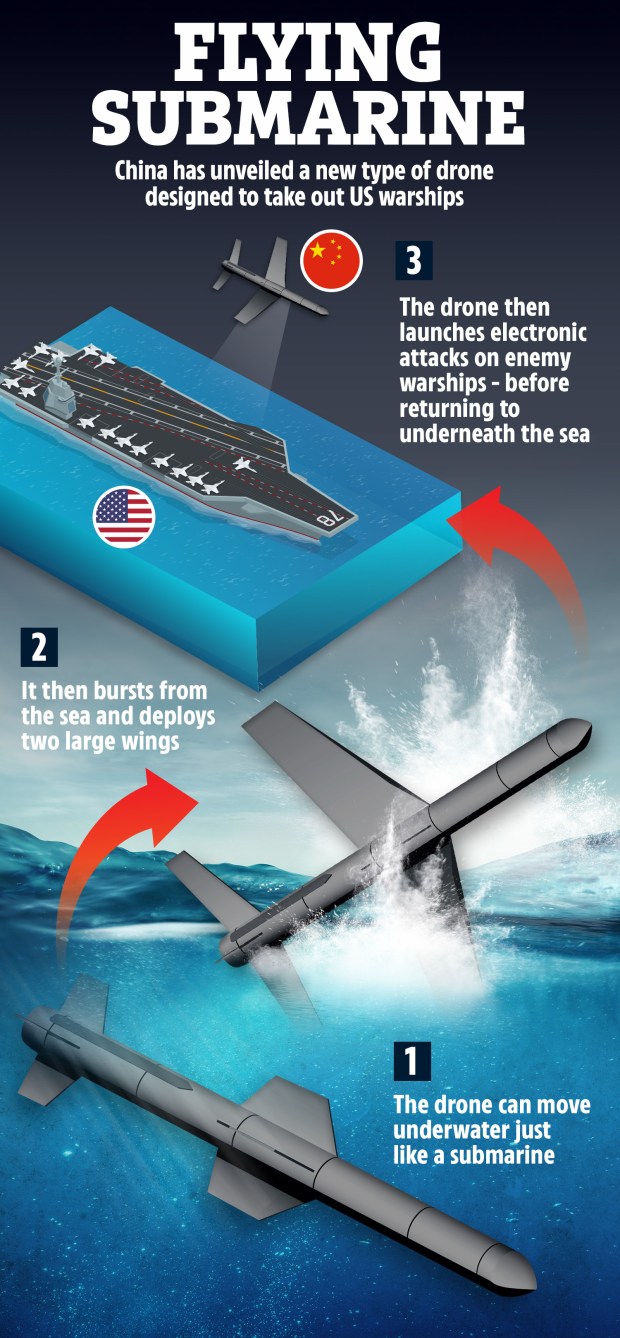
A prototype flying submarine drone has already been built and tested in a research lab at Nanjing University of Aeronautics and Astronautics, reports the South China Morning Post.
The stealth drone is driven by four propellers, including a pair at the front that tilt.
It glides under the water with a pair of large wings folded over its back, giving it a classic streamlined submarine shape.
At the surface, the wings pop out at it soars into the air at 75mph - twice as fast as an ordinary drone powered by rotor blades.
Researchers claim the drone can approach an underwater target slowly and linger in one area for a long time.
It “consumes little energy when cruising in fixed-wing mode, so it can perform some fast, long-range missions in the air”, professor Ang Haisong said in a research journal.
Prof Ang’s team built two scaled-down prototypes with wing spans of about 6ft 6in, according to their paper.
Larger real-life versions would be have a wide range of civilian and military uses such as inspecting underwater mines, the boffins say.
Experts say the real benefit is the ability to dodge air and sea defences to launch surprise kamikaze attacks.
Meanwhile other Chinese teams are working on numerous other types of "transmedia vessels", reports the Morning Post.
“They are mainly for military applications. Some can fly at supersonic speed,” said a researcher at Northwestern Polytechnical University in Xian.
Professor Ji Wanfeng of the Naval Aviation University in Yantai said this type of vessel is one of the cheapest, most effective methods to cripple the defences of an aircraft carrier fleet.
A modern warship's multilayered defence system can shoot down about half of approaching planes, missiles or traditional drones, according to an estimate by Prof Ji and his colleagues.
But a transmedia vessel can go underwater when detected by radar and resurface to dodge sonar.
Just a small number of these drones could confuse or even overwhelm a warship’s defences, Prof Ji said.
A transmedia vessel launched from a distance of 62 miles had a survival rate of nearly 100 per cent if it could fly at over 90mph, his team said in a paper published in the Chinese journal Electronics Optics & Control last month.
It added the drones “can achieve efficient strikes against the enemy’s key targets. It will surely become a powerful supplement to the Chinese navy’s existing equipment combat methods and tactics.”
The flying sub built by Prof Ang’s team has an airbag in its belly filled with water to adjust buoyancy so it can lurk silently at a given depth without using its propellers.
When cruising with its wings folded, its streamlined body allows for less drag and higher mobility.
The biggest challenge was during take-off, according to Ang’s team.
If the vessel rises directly out of the water, the take-off is unstable because of surface waves and the drone’s simultaneous interaction with air and water.
To fix this, they developed a complex control mechanism so that the submarine can glide on the waves before lifting into the air.
Last week Chinese forces surrounded the island and fired a barrage of ballistic missiles in huge war games feared to be cover for a possible invasion.
Some experts believe China is now leading the global high-tech arms race as it invests billions in a terrifying array of new weapons.
Last year it emerged Chinese scientists had secretly been working on AI stealth subs since the 1990s.
A research paper shows how a prototype could autonomously track and destroy targets with no human input.
China is also developing aerial stealth drones, suicide drone swarms and atmosphere-skimming hypersonic missiles to match Russia's.
The idea of a flying submarine has been around since the 1920s.
In 1934, Soviet engineering student Boris Ushakov drew up detailed plans for a three-engined submersible plane that could scout for ships and then dive into the water to ambush them with torpedoes.
But the Red Army ditched it because the underwater components made the aircraft too heavy.
In 1962, US defence engineer Donald Reid actually built the world's first flying submarine RFS-1, a low-tech machine made from salvaged aircraft parts in his spare time.
The pilot had to take off the propeller before diving underwater to keep the engine dry, and breathed with an aqualung.
But the craft only flew a short distance because of insufficient power, and he failed to get a backer to develop it further.
At the time, Convair was developing a submersible seaplane for the US Navy but the project was abandoned after technical challenges.
More recently in 2008, the Pentagon's $3bn-a-year Defense Advanced Research Projects Agency announced it was accepting proposals for a stealth aircraft that can transform into an attack submarine.
https://www.the-sun.com/news/5960968/china-tests-flying-submarine-drone-aircraft-carrier/#
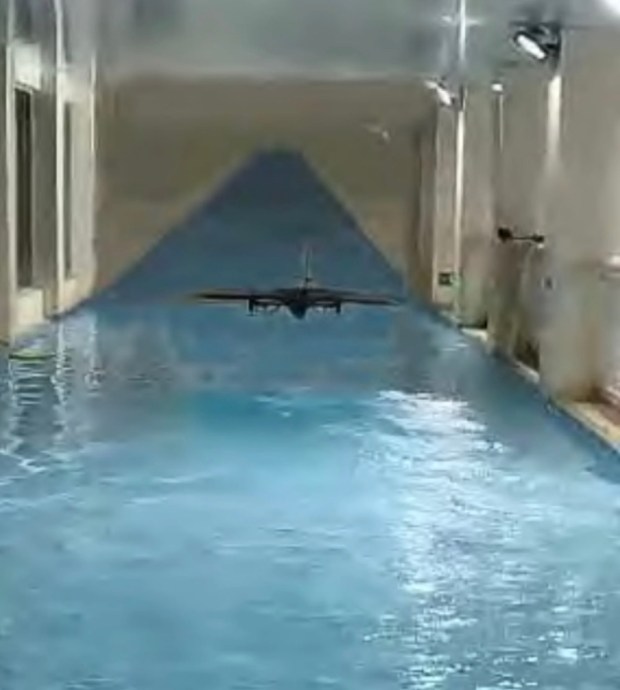
The prototype drone being tested at Nanjing University in ChinaCredit: Nanjing University of Aeronautics and Astronautics
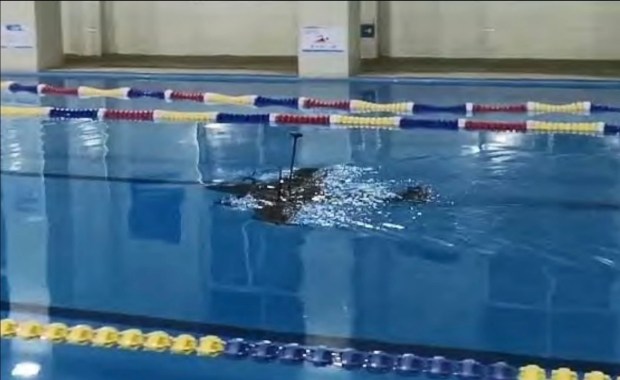
Researchers say they solved the complex problem of unstable take-offCredit: Nanjing University of Aeronautics and Astronautics
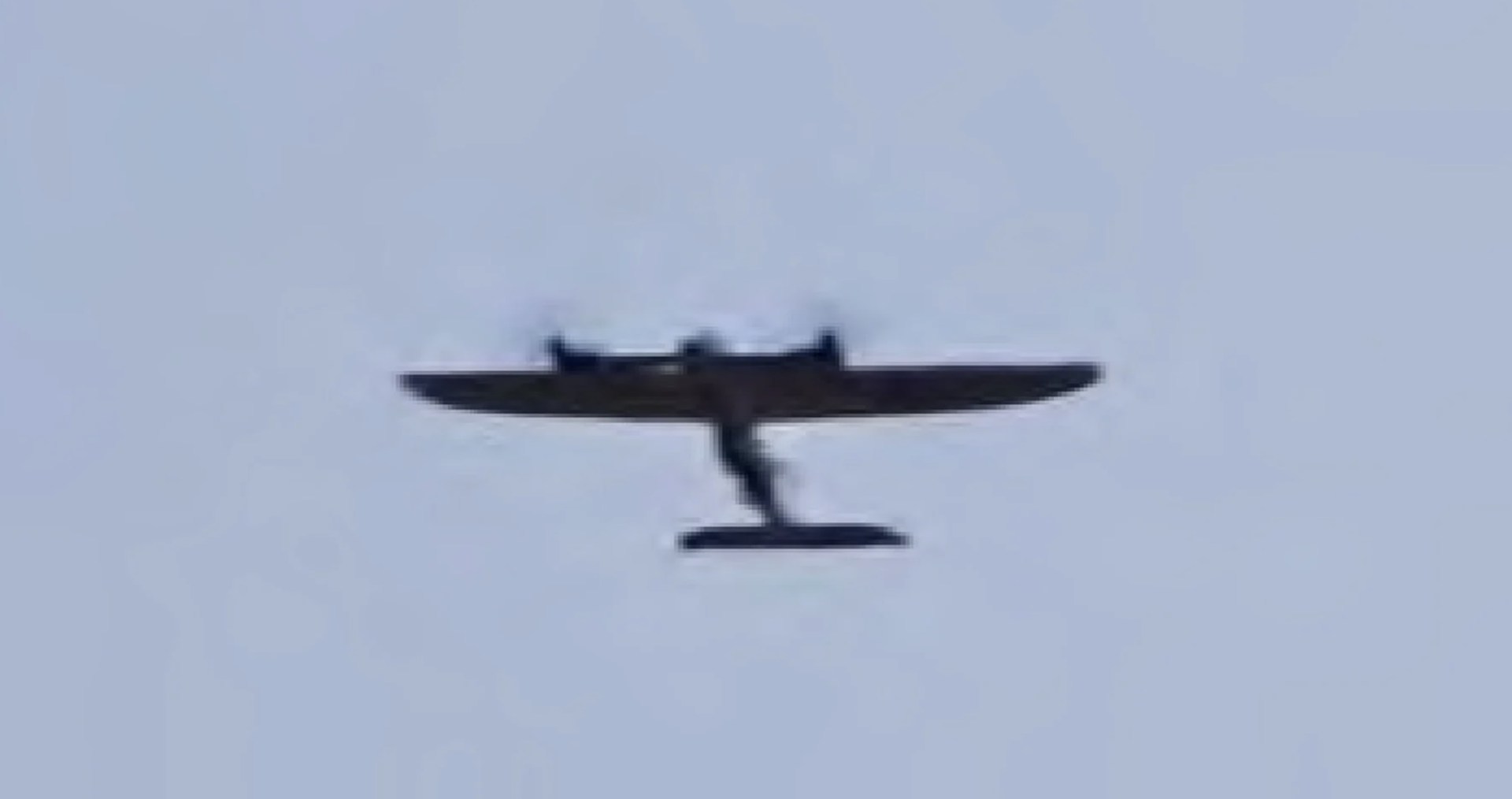
 www.the-sun.com
www.the-sun.com
China tests ‘flying submarine’ drone ‘capable of taking US aircraft carriers’ in plans for fleet of supersonic AI craft
- 7:15 ET, Aug 9 2022
- Updated: 7:33 ET, Aug 9 2022

CHINESE scientists are developing flying submarines designed to burst from the water and take to the skies on fold-out wings.
The sinister stealth craft are meant to dodge both radar and sonar and could hunt in packs to ambush aircraft carriers, experts say.

A prototype Chinese drone can sail underwater and fly at 75mph on fold-out wingsCredit: Nanjing University of Aeronautics and Astronautics

A prototype flying submarine drone has already been built and tested in a research lab at Nanjing University of Aeronautics and Astronautics, reports the South China Morning Post.
The stealth drone is driven by four propellers, including a pair at the front that tilt.
It glides under the water with a pair of large wings folded over its back, giving it a classic streamlined submarine shape.
At the surface, the wings pop out at it soars into the air at 75mph - twice as fast as an ordinary drone powered by rotor blades.
Researchers claim the drone can approach an underwater target slowly and linger in one area for a long time.
It “consumes little energy when cruising in fixed-wing mode, so it can perform some fast, long-range missions in the air”, professor Ang Haisong said in a research journal.
Prof Ang’s team built two scaled-down prototypes with wing spans of about 6ft 6in, according to their paper.
Larger real-life versions would be have a wide range of civilian and military uses such as inspecting underwater mines, the boffins say.
Experts say the real benefit is the ability to dodge air and sea defences to launch surprise kamikaze attacks.
Meanwhile other Chinese teams are working on numerous other types of "transmedia vessels", reports the Morning Post.
“They are mainly for military applications. Some can fly at supersonic speed,” said a researcher at Northwestern Polytechnical University in Xian.
Professor Ji Wanfeng of the Naval Aviation University in Yantai said this type of vessel is one of the cheapest, most effective methods to cripple the defences of an aircraft carrier fleet.
A modern warship's multilayered defence system can shoot down about half of approaching planes, missiles or traditional drones, according to an estimate by Prof Ji and his colleagues.
But a transmedia vessel can go underwater when detected by radar and resurface to dodge sonar.
Just a small number of these drones could confuse or even overwhelm a warship’s defences, Prof Ji said.
A transmedia vessel launched from a distance of 62 miles had a survival rate of nearly 100 per cent if it could fly at over 90mph, his team said in a paper published in the Chinese journal Electronics Optics & Control last month.
It added the drones “can achieve efficient strikes against the enemy’s key targets. It will surely become a powerful supplement to the Chinese navy’s existing equipment combat methods and tactics.”
The flying sub built by Prof Ang’s team has an airbag in its belly filled with water to adjust buoyancy so it can lurk silently at a given depth without using its propellers.
When cruising with its wings folded, its streamlined body allows for less drag and higher mobility.
The biggest challenge was during take-off, according to Ang’s team.
If the vessel rises directly out of the water, the take-off is unstable because of surface waves and the drone’s simultaneous interaction with air and water.
To fix this, they developed a complex control mechanism so that the submarine can glide on the waves before lifting into the air.
Arms race
The timing of the research paper is significant as it comes amid heightened fears Beijing will start a war to seize self-ruled Taiwan.Last week Chinese forces surrounded the island and fired a barrage of ballistic missiles in huge war games feared to be cover for a possible invasion.
Some experts believe China is now leading the global high-tech arms race as it invests billions in a terrifying array of new weapons.
Last year it emerged Chinese scientists had secretly been working on AI stealth subs since the 1990s.
A research paper shows how a prototype could autonomously track and destroy targets with no human input.
China is also developing aerial stealth drones, suicide drone swarms and atmosphere-skimming hypersonic missiles to match Russia's.
The idea of a flying submarine has been around since the 1920s.
In 1934, Soviet engineering student Boris Ushakov drew up detailed plans for a three-engined submersible plane that could scout for ships and then dive into the water to ambush them with torpedoes.
But the Red Army ditched it because the underwater components made the aircraft too heavy.
In 1962, US defence engineer Donald Reid actually built the world's first flying submarine RFS-1, a low-tech machine made from salvaged aircraft parts in his spare time.
The pilot had to take off the propeller before diving underwater to keep the engine dry, and breathed with an aqualung.
But the craft only flew a short distance because of insufficient power, and he failed to get a backer to develop it further.
At the time, Convair was developing a submersible seaplane for the US Navy but the project was abandoned after technical challenges.
More recently in 2008, the Pentagon's $3bn-a-year Defense Advanced Research Projects Agency announced it was accepting proposals for a stealth aircraft that can transform into an attack submarine.
https://www.the-sun.com/news/5960968/china-tests-flying-submarine-drone-aircraft-carrier/#

The prototype drone being tested at Nanjing University in ChinaCredit: Nanjing University of Aeronautics and Astronautics

Researchers say they solved the complex problem of unstable take-offCredit: Nanjing University of Aeronautics and Astronautics

China tests chilling ‘flying sub’ drone for fleet of supersonic AI craft
CHINESE scientists are developing flying submarines designed to burst from the water and take to the skies on fold-out wings. The sinister stealth craft are meant to dodge both radar and sonar and …

